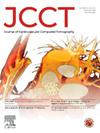利用基于人工智能的全自动左房室耦合指数预测经导管主动脉瓣置换术后的死亡率。
IF 5.5
2区 医学
Q1 CARDIAC & CARDIOVASCULAR SYSTEMS
引用次数: 0
摘要
背景:本研究旨在确定基于人工智能(AI)的左房室耦合指数(LACI)自动评估是否可以为严重主动脉狭窄(AS)患者在经导管主动脉瓣置换术(TAVR)前行冠状动脉CT血管造影(CCTA)预测死亡率提供高于其他传统危险因素的增量价值。方法:本回顾性研究评估了2014年9月至2020年12月在TAVR前接受CCTA检查的严重AS患者。ai原型软件全自动计算左心房和左心室舒张末期容积,并通过它们之间的比值定义LACI。采用单因素和多因素Cox比例风险法,在调整相关显著参数和胸外科学会预测死亡风险(STS-PROM)评分的模型中确定死亡率的预测因素。结果:共656例患者(77岁[IQR, 71-84岁];387例(59.0%)男性被纳入最终队列。全因死亡率为21.6%,中位随访时间24(10-40)个月。当调整临床混杂因素时,LACI≥43.7%独立预测死亡率(调整后HR为1.52,[95% CI: 1.03, 2.22];p = 0.032)。在单独模型中调整STS-PROM评分后,LACI≥43.7%仍然是一个独立的预后参数(调整后HR为1.47,[95% CI: 1.03-2.08];p = 0.031)。在保留左室射血分数的患者的亚分析中,LACI仍然是一个重要的预测因子(调整后HR, 1.72 [95% CI: 1.02, 2.89];p = 0.042)。结论:基于人工智能的LACI全自动评估可独立用于预测TAVR患者的死亡率,包括保留LVEF的患者。本文章由计算机程序翻译,如有差异,请以英文原文为准。
Predicting mortality after transcatheter aortic valve replacement using AI-based fully automated left atrioventricular coupling index
Background
This study aimed to determine whether artificial intelligence (AI)–based automated assessment of left atrioventricular coupling index (LACI) can provide incremental value above other traditional risk factors for predicting mortality among patients with severe aortic stenosis (AS) undergoing coronary CT angiography (CCTA) before transcatheter aortic valve replacement (TAVR).
Methods
This retrospective study evaluated patients with severe AS who underwent CCTA examination before TAVR between September 2014 and December 2020. An AI-prototype software fully automatically calculated left atrial and left ventricular end-diastolic volumes and LACI was defined by the ratio between them. Uni- and multivariate Cox proportional hazard methods were used to identify the predictors of mortality in models adjusting for relevant significant parameters and Society of Thoracic Surgeons Predicted Risk of Mortality (STS-PROM) score.
Results
A total of 656 patients (77 years [IQR, 71–84 years]; 387 [59.0 %] male) were included in the final cohort. The all-cause mortality rate was 21.6 % over a median follow-up time of 24 (10–40) months. When adjusting for clinical confounders, LACI ≥43.7 % independently predicted mortality (adjusted HR, 1.52, [95 % CI: 1.03, 2.22]; p = 0.032). After adjusting for the STS-PROM score in a separate model, LACI ≥43.7 % remained an independent prognostic parameter (adjusted HR, 1.47, [95 % CI: 1.03–2.08]; p = 0.031). In a sub-analysis of patients with preserved left ventricular ejection fraction, LACI remained a significant predictor (adjusted HR, 1.72 [95 % CI: 1.02, 2.89]; p = 0.042).
Conclusions
AI-based fully automated assessment of LACI can be used independently to predict mortality in patients undergoing TAVR, including those with preserved LVEF.
求助全文
通过发布文献求助,成功后即可免费获取论文全文。
去求助
来源期刊

Journal of Cardiovascular Computed Tomography
CARDIAC & CARDIOVASCULAR SYSTEMS-RADIOLOGY, NUCLEAR MEDICINE & MEDICAL IMAGING
CiteScore
7.50
自引率
14.80%
发文量
212
审稿时长
40 days
期刊介绍:
The Journal of Cardiovascular Computed Tomography is a unique peer-review journal that integrates the entire international cardiovascular CT community including cardiologist and radiologists, from basic to clinical academic researchers, to private practitioners, engineers, allied professionals, industry, and trainees, all of whom are vital and interdependent members of our cardiovascular imaging community across the world. The goal of the journal is to advance the field of cardiovascular CT as the leading cardiovascular CT journal, attracting seminal work in the field with rapid and timely dissemination in electronic and print media.
 求助内容:
求助内容: 应助结果提醒方式:
应助结果提醒方式:


